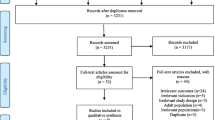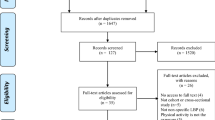Abstract
Purpose
To identify and evaluate the effectiveness of conservative treatment approaches used in children and adolescents to manage and prevent low back pain (LBP).
Methods
Five electronic databases and the reference lists of systematic reviews were searched for relevant studies. Randomised controlled trials (RCTs) were considered eligible for inclusion if they enrolled a sample of children or adolescents (<18 years old) and evaluated the effectiveness of any conservative intervention to treat or prevent LBP. Two authors independently screened search results, extracted data, assessed risk of bias using the PEDro scale, and rated the quality of evidence using the GRADE criteria.
Results
Four RCTs on intervention and eleven RCTs on prevention of LBP were included. All included studies had a high risk of bias scoring ≤7 on the PEDro scale. For the treatment of LBP, a supervised exercise program compared to no treatment improved the average pain intensity over the past month by 2.9 points (95 % CI 1.6–4.1) measured by a 0–10 scale (2 studies; n = 125). For the prevention of LBP, there was moderate quality evidence to suggest back education and promotion programs are not effective in reducing LBP prevalence in children and adolescents.
Conclusions
While exercise interventions appear to be promising to treat LBP in children and adolescents, there is a dearth of research data relevant to paediatric populations. Future studies conducted in children and adolescents with LBP should incorporate what has been learnt from adult LBP research and be of rigorous methodological quality.


Similar content being viewed by others
References
Woolf A, Pfleger B (2003) Burden of major musculoskeletal conditions. Bull World Health Organ 81:646–656
Jeffries L, Milanese S, Grimmer-Somers K (2007) Epidemiology of adolescent spinal pain a systematic overview of the research literature. Spine 32:2630–2637
Briggs A, Buchbinder R (2009) Back pain: a national health priority area in Australia? Med J Aust 190:499–502
Balagué F et al (1995) Low back pain in schoolchildren: a study of familial and psychological factors. Spine 20:1265–1270
Taimela S et al (1997) The prevalence of low back pain among children and adolescents: a nationwide, Cohort-Based Questionnaire Survey in Finland. Spine 22:1132–1136
King S et al (2011) The epidemiology of chronic pain in children and adolescents revisited: a systematic review. Pain 152:2729–2738
Watson K et al (2002) Low back pain in schoolchildren: occurrence and characteristics. Pain 97:87–92
Ochsmann E et al (2010) Prevalence of diagnosis and direct treatment costs of back disorders in 644,773 children and youths in Germany. BMC Musculoskeletal Disorders 11:193
Hestbaek L, Leboeuf-Yde C, Kyvik K (2006) Are lifestyle-factors in adolescence predictors for adult low back pain? A cross-sectional and prospective study of young twins. BMC Musculoskeletal Disorders 7:27
Kosseim M, Rein R, McShane C (2008) Implementing evidence-based physiotherapy practice for treating children with low back pain: are we there yet? Pediatr Phys Ther 20:179–184
Jebaseelan DD et al (2012) Sensitivity studies of pediatric material properties on juvenile lumbar spine responses using finite element analysis. Med Biol Eng Comput 50:515–522
Junewick JJ (2010) Cervical spine injuries in pediatrics: are children small adults or not? Pediatr Radiol 40:493–498
Koes BW et al (2010) An updated overview of clinical guidelines for the management of non-specific low back pain in primary care. Eur Spine J 19:2075–2094
Steele EJ, Dawson AP, Hiller JE (2006) School-based interventions for spinal pain: a systematic review. Spine (Phila Pa 1976) 31:226–233
Calvo-Munoz I, Gomez-Conesa A, Sanchez-Meca J (2013) Physical therapy treatments for low back pain in children and adolescents: a meta-analysis. BMC Musculoskelet Disord 14:55
Furlan AD et al (2009) 2009 updated method guidelines for systematic reviews in the Cochrane Back Review Group. Spine 34:1929–1941
Macedo LG et al (2010) There was evidence of convergent and construct validity of Physiotherapy Evidence Database quality scale for physiotherapy trials. J Clin Epidemiol 63:920–925
Maher CG et al (2003) Reliability of the PEDro scale for rating quality of randomized controlled trials. Phys Ther 83:713–721
Atkins D et al (2004) Grading quality of evidence and strength of recommendations. BMJ 328:1490
Adams R et al (2002) Recommendations for improving the quality of care through stroke centers and systems: an examination of stroke center identification options: multidisciplinary consensus recommendations from the Advisory Working Group on Stroke Center Identification Options of the American Stroke Association. Stroke 33:e1–e7
Henschke N et al (2010) Behavioural treatment for chronic low-back pain. Cochrane Database Syst Rev 7:CD002014
Guyatt GH et al (2011) GRADE guidelines 6. Rating the quality of evidence–imprecision. J Clin Epidemiol 64:1283–1293
Guyatt GH et al (2008) Rating quality of evidence and strength of recommendations: GRADE: an emerging consensus on rating quality of evidence and strength of recommendations. BMJ 336:924
Jones M et al (2007) The efficacy of exercise as an intervention to treat recurrent nonspecific low back pain in adolescents. Pediatr Exerc Sci 19:349–359
Jones MA et al (2007) Recurrent non-specific low-back pain in adolescents: the role of exercise. Ergonomics 50:1680–1688
Fanucchi GL et al (2009) Exercise reduces the intensity and prevalence of low back pain in 12–13 year old children: a randomised trial. Aust J Physiother 55:97–104
Ahlqwist A et al (2008) Physical therapy treatment of back complaints on children and adolescents. Spine (Phila Pa 1976) 33:E721–E727
Candy EA et al (2012) Effect of a high-density foam seating wedge on back pain intensity when used by 14 to 16-year-old school students: a randomised controlled trial. Physiotherapy 98:301–306
Bauer DH, Freivalds A (2009) Backpack load limit recommendation for middle school students based on physiological and psychophysical measurements. Work 32:339–350
Cardon GM et al (2007) Back education in elementary schoolchildren: the effects of adding a physical activity promotion program to a back care program. Eur Spine J 16:125–133
Dolphens M et al (2011) Long-term effectiveness of a back education programme in elementary schoolchildren: an 8-year follow-up study. Eur Spine J 20:2134–2142
Feingold AJ, Jacobs K (2002) The effect of education on backpack wearing and posture in a middle school population. Work 18:287–294
Gallardo Vidal M, Rodríguez Barrientos R, Borda Olivas A (2012) Evaluación de la efectividad de una intervención educativa para disminuir el peso de la mochila escolar en los alumnos de 3. y 4. de educación primaria. Fisioterapia
Geldhof E et al (2006) Effects of a two-school-year multifactorial back education program in elementary schoolchildren. Spine (Phila Pa 1976) 31:1965–1973
Geldhof E et al (2007) Back posture education in elementary schoolchildren: a 2-year follow-up study. Eur Spine J 16:841–850
Kovacs F et al (2011) Improving schoolchildren’s knowledge of methods for the prevention and management of low back pain: a cluster randomized controlled trial. Spine (Phila Pa 1976) 36:E505–E512
Linton SJ et al (1994) The effects of ergonomically designed school furniture on pupils’ attitudes, symptoms and behaviour. Appl Ergon 25:299–304
Moreira RF et al (2012) Effects of a school based exercise program on children’s resistance and flexibility. Work 41(Suppl 1):922–928
Spence SM, Jensen GM, Shepard KF (1984) Comparison of methods of teaching children proper lifting techniques. Phys Ther 64:1055–1061
Vidal J et al (2013) Effects of a postural education program on school backpack habits related to low back pain in children. Eur Spine J 22:782–787
Verhagen AP et al (1998) The Delphi list: a criteria list for quality assessment of randomized clinical trials for conducting systematic reviews developed by Delphi consensus. J Clin Epidemiol 51:1235–1241
Jüni P, Altman DG, Egger M (2001) Systematic reviews in health care: assessing the quality of controlled clinical trials. BMJ 323:42
Hayden JA et al (2005) Meta-analysis: exercise therapy for nonspecific low back pain. Ann Intern Med 142:765–775
McGrath PJ et al (2008) Core outcome domains and measures for pediatric acute and chronic/recurrent pain clinical trials: PedIMMPACT recommendations. J Pain 9:771–783
Conflict of interest
None of the authors involved in the preparation of this manuscript have any potential, perceived or real conflict to disclose.
Author information
Authors and Affiliations
Corresponding author
Electronic supplementary material
Below is the link to the electronic supplementary material.
Appendix 1
Appendix 1
Example search strategy for MEDLINE (OVID). The search terms were modified slightly for other databases. These are available on request from the authors.
Part A: generic search for randomised controlled trials and controlled clinical trials
1. randomised controlled trial.pt.
2. controlled clinical trial.pt.
3. comparative study.pt.
4. clinical trial.pt.
5. randomised.ab.
6. placebo.ab,ti.
7. drug therapy.fs.
8. randomly.ab,ti.
9. trial.ab,ti.
10. groups.ab,ti.
11. 1 or 2 or 3 or 4 or 5 or 6 or 7 or 8 or 9 or 10
12. (animals not (humans and animals)).sh.
13. 11 not 12
Part B: specific search for thoracic, low back, sacrum and coccyx problems
14. dorsalgia.ti,ab.
15. exp Back Pain/
16. backache.ti,ab.
17. exp Low Back Pain/
18. (lumbar adj pain).ti,ab.
19. coccyx.ti,ab.
20. coccydynia.ti,ab.
21. sciatica.ti,ab.
22. sciatic neuropathy/
23. spondylosis.ti,ab.
24. lumbago.ti,ab.
25. back disorder$.ti,ab.
26. or/14‐25
Part C: sensitive search for children and adolescents
27. child$.ti,ab.
28. adolesce$.ti,ab.
29. youth$.ti,ab.
30. school$.ti,ab.
31. student$.ti,ab.
32. teena$.ti,ab.
33. young.ti,ab.
34. 27 or 28 or 29 or 30 or 31 or 32 or 33
Part D: combined search
35. 13 AND 26 AND 34
Rights and permissions
About this article
Cite this article
Michaleff, Z.A., Kamper, S.J., Maher, C.G. et al. Low back pain in children and adolescents: a systematic review and meta-analysis evaluating the effectiveness of conservative interventions. Eur Spine J 23, 2046–2058 (2014). https://doi.org/10.1007/s00586-014-3461-1
Received:
Revised:
Accepted:
Published:
Issue Date:
DOI: https://doi.org/10.1007/s00586-014-3461-1




